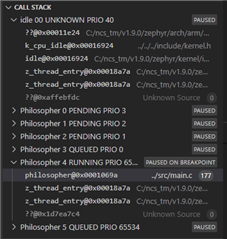Hello Devzone Community,
My name is Ted, and I am continuing my effort to configure a Zephyr based, Nordic aws_iot sample app based firmware to run and support nRF9160 lowest specified power consumption. I am in the process of putting all application threads to sleep, so that Zephyr's idle thread can put the application processor into a low power sleep mode. Nordic Power Profiler waveforms of measured current draw, however, indicate that I've failed in this. Some part of the overall firmware binary appears to be yet running. Lowest average current I achieve is ~190 microamps.
My Devzone account doesn't permit me to upload photos, but here is a link to two captures from Nordic's power profile which I took earlier today. My apology that I must include an external link here and not the images directly:
* wiki.neelanurseries.com/.../20220311
The first one shows a general pattern of current regularly spiking from a few microamps to around three milliamps. The zoomed capture shows the ten millisecond spikes, a more distinct fast spike and a more blunted longer duration one.
These are taken during a 45 second period when all my application threads are sleeping -- for 45 seconds -- and LTE modem is turned off, and GPIOs to hardware enable points of our board are also turned off, effectively powering down the hardware outside the nRF9160.
From these waveforms I observe that some ARM processor activity appears to be consuming current every ten milliseconds. But though I have put my app threads into a nearly minute long sleep period, and have searched for the sleep periods set on aws_iot sample app threads, I cannot see any firmware configured device or service that is configured to run every ten milliseconds.
This work is based on Nordic's aws_iot sample app, as it appears in ncs v1.6.1. The sample app creates three or four Zephyr threads. Zephyr itself creates a thread for `int main()` and an idle thread. Work of my own adds a few more threads at run time. These latest threads I can readily put to sleep for minutes or even hours, with a call to k_sleep() in a given thread's effective main function.
I have enabled Zephyr's thread_analyzer feature, and can observe simple reporting at run time of the threads of this firmware. Here is a typical Zephyr output I can see via a serial connection, and using a simple CLI to invoke a handful of commands:
Excerpt 1: Zephyr thread summary report
```1) 'thread_accelerometer' stack size 2048 bytes, stack used 960 bytes, 46%
2) 'thread_dev_work' stack size 3072 bytes, stack used 1504 bytes, 48%
3) 'thread_simple_cli' stack size 4096 bytes, stack used 1768 bytes, 43%
4) 'thread_led' stack size 512 bytes, stack used 136 bytes, 26%
5) 'download_client' stack size 4096 bytes, stack used 104 bytes, 2%
6) 'at_cmd_socket_thread' stack size 1472 bytes, stack used 688 bytes, 46%
7) 'time_thread' stack size 1024 bytes, stack used 728 bytes, 71%
8) 'connection_poll_thread' stack size 3072 bytes, stack used 296 bytes, 9%
9) '0x20015ab0' stack size 1024 bytes, stack used 168 bytes, 16%
10) 'sysworkq' stack size 2048 bytes, stack used 168 bytes, 8%
11) 'idle 00' stack size 320 bytes, stack used 56 bytes, 17%```
Here I modify the report to annotate each thread's origin, which affects how easily or not I can adjust a thread's sleep time:
Excerpt 2:
```1) 'thread_accelerometer' . . . home authored application
2) 'thread_dev_work' . . . home authored application
3) 'thread_simple_cli' . . . home authored application
4) 'thread_led' . . . home authored application
5) 'download_client' . . . aws_iot sample app
6) 'at_cmd_socket_thread' . . . aws_iot sample app
7) 'time_thread' . . . aws_iot sample app
8) 'connection_poll_thread' . . . aws_iot sample app
9) '0x20015ab0' . . . ?, not known
10) 'sysworkq' . . . Zephyr 2.6.0
11) 'idle 00' . . . Zephyr 2.6.0```
So far I have been able to track down in Zephyr's dwt.h library header file that the time thread has a default sleep period of 3600 seconds. Tracing thread 'at_cmd_socket_thread' which is implemented in ncs/nrf/subsys/net/lib/aws_iot/src/aws_iot.c I cannot tell what this thread's effective sleep period is.
Question (1): Can a Devzone team member or community member help me identify where this thread's sleep time is realized?
I have yet to find the implementation details for thread 'download_client', 'connection_poll_thread' and '0x20015ab0'. The last of these threads I have concern for. It is not named, and so I cannot be sure whether it is a Zephyr construct or a Nordic sample app construct. This unnamed thread has shown in the thread analyzer report since I enabled Zephyr's analyzer.
Question (2): is static code analysis the only way to learn "who" in the Zephyr and other source codes is creating the unnamed thread?
Until I can identify the unnamed thread, I won't know whether I can cleanly properly adjust its sleep period. If it is a kernel thread, my app space firmware won't automatically have privileges to make any changes to a kernel thread. I believe there are some extra steps to be able to do so, if that is even possible.
I recognize also that I cannot simply change sleep times of the aws_iot sample app threads, and expect celular level and MQTT client-broker connections to continue to function. I'll need to study and find a way to cleanly close connections before putting such threads to sleep.
Thanks ahead of time to all who can shed some light and help on these deep sleep and nRF9160 power saving questions!
- Ted

